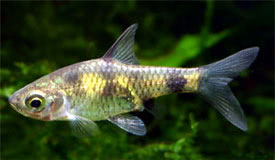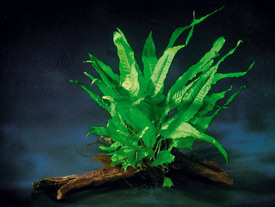
 Magyarul / Hungarian
Magyarul / Hungarian




- Scientific name: Austrolebias nigripinnis
- Synonyms: Cynolebias nigripinnis, Cynolebias nigripinnis nigripinnis
- Common name: Blackfin Pearl Killifish, Dwarf Argentine Pearl
- Group: Killifish
- Habitat: South America; Argentina, Uruguay
- Size: 5-6 cm
- Biotope: Inhabits in small rivers, streams and temporary waters with muddy beds, that dry up at parts of the year.
- Social behavior: Males are very aggressive and they may harass unreceptive females excessively. Best kept in its own tank. Do not keep two males in the same tank.
- Diet: Omnivorous; They will eat small live and frozen foods, also good quality flake foods.
- Breeding: Quite hard
- Tank: Minimum 30 litres
- Population: 1 male and 2-3 females for 40 litres
- Decoration: Use dark substrate (peat), and provide hiding places with wood and roots. Filter their water through peat.
- Temperature: 16-22 °C
- pH: 5.5-6.7
- Hardness: 1-8 NK°
- Lifespan: 3-5 years
Description: Mature males have a blue-black body color that extends onto the fins. The body is marked with numerous iridescent, blue-white spots. Just below the dark edges of the anal and dorsal fins, these spots run together to form a broken stripe. The caudal fin has 5 - 6 concentric arced lines of turquoise spots. Females are dull yellow-gray with irregular dark spots. The fins are brown-gray. Blackfin Pearl Killifish are quite sensitive, and requires well-maintained water with frequent partial water changes. They can tolerate much lower temperatures than many other annual killifish, in fact higher temperatures (above 25 °C) should be avoided, because they will lose some colors and live for shorter periods.
Males are more colorful and darker especially in the spawning season. Austrolebias nigripinnis can be bred in small tanks with peat substrate and driftwood hiding places for the female. Water should be soft (1-4 dH), acidic (pH around 6.0) with a temperature of 20-22 °C. The male takes over an area and defends it against other males. When the female is ready to spawn, she will approach the male’s territory with a tilted down body. The pair spawns on the bottom and the female will deposit her eggs in the substrate. In their natural habitat the water evaporates, and the adults die, but the eggs survive and then hatch in the next rainy season.
After breeding the peat (which containing the eggs) should be kept in a dark and cool area, as they are sensitive to light. The eggs can be stored for several months or even for years in these conditions. The eggs can be incubated in 1,5-3 cm deep water, where they hatch within hours when getting wet. The tiny fry can be fed with infusoria in the first days. After about 2 days they can be fed with small Brine Shrimp nauplii. The fry should initially be kept in very shallow water but the level can be raised as the fry grow.





